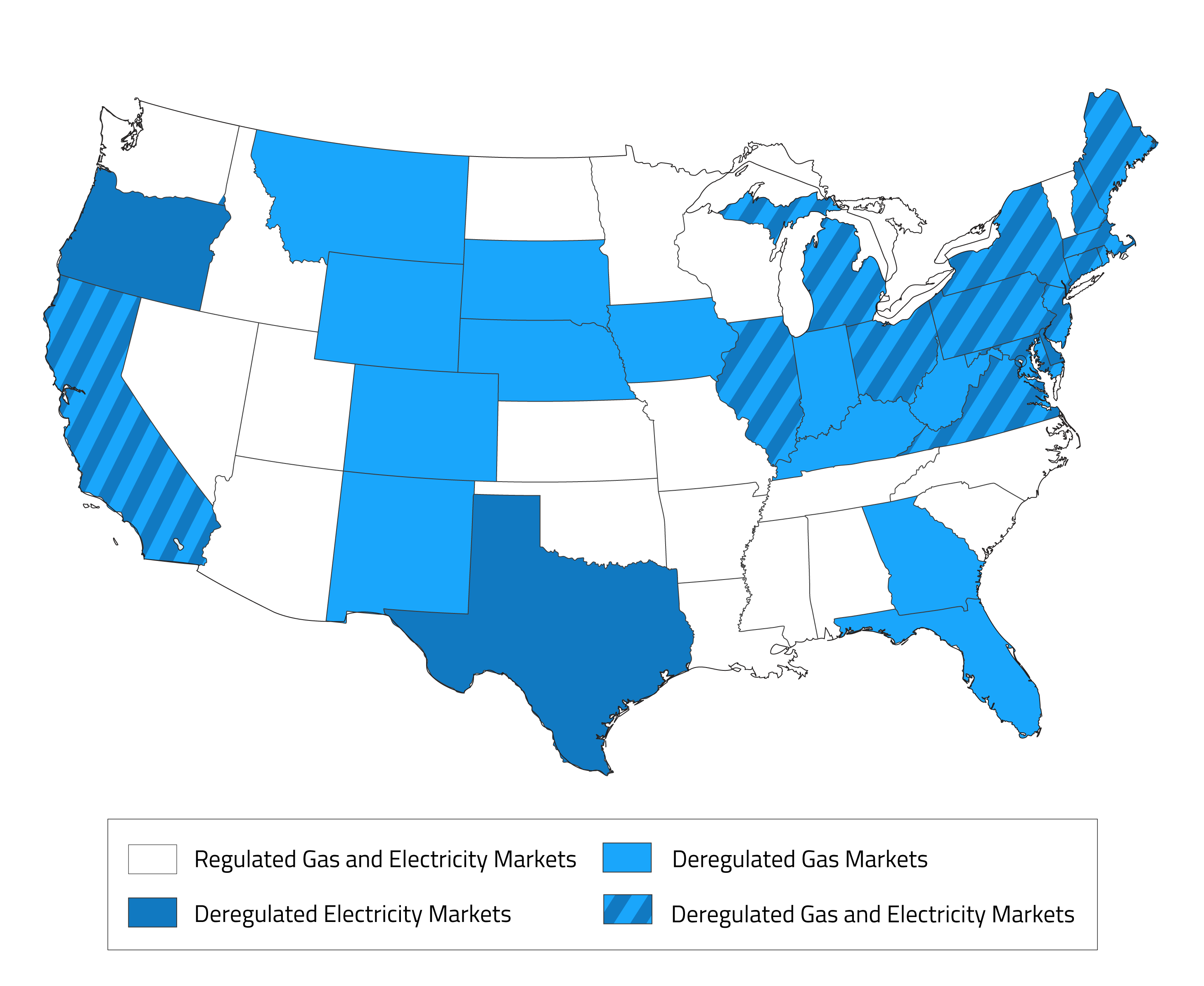| 29 States have Restructured Markets for electricity and/or gas. Texas is the leader, where more than 85% of residents have access to a competitive energy market. |  Graphic: https://www.electricchoice.com/map-deregulated-energy-markets/ |
| Competition benefits the consumer | In the decades since deregulation started, competitive energy markets have delivered reliable service to individuals at lower cost. Freedom to choose in electricity markets is a liberty more and more Americans enjoy. |
| Clean energy has been adopted faster in deregulated states | In restructured markets, consumers have the option of choosing where their power is sourced from. Making an investment in clean technology is widely available whether it be from a physical installation or choosing a utility scale provider. Unlike regulated markets, where consumers are bound to specific offerings from the utility, consumers are able to make informed decisions about their energy portfolio. |
The monopoly model of electricity distribution has gradually shifted to a competitive marketplace since the mid 1990s. This transition has empowered consumers to solicit their power from a broader array of providers and gain benefits that an organized market provides. Today these decisions in some states are as accessible as choosing a cell phone plan. Since the series of restructuring reforms that took place two decades ago, states have proven this model to be effective. Consumers respond to choices, allowing them to source their power in a competitive marketplace, which in turn brings better prices and a wider array of options. 29 states currently offer their citizens energy choice for gas or electricity purchases.
Deregulated States as a model
Since the major reforms of the 1990s, competitive markets have proven their merits, even though adoption of this approach has not become universal. These state level policies are mixed with overarching priorities from the Energy Department and regulatory oversight from Federal Energy Regulatory Commission (FERC). In restructured states, the utility itself is less likely to own generation and transmission resources, whereas the traditional regulated approach would be vertically integrated from generation, transmission, and distribution.
Texas has become a case study for how a competitive market directly benefits consumers. Deep in the heart of oil and gas country, Texas has quietly become the nationwide leader in installed wind capacity, with neighboring Oklahoma (a monopoly market) a distant second.
Benefits to consumers
Consumers under a monopoly model are disadvantaged due to a lack of choice. The impact from this lack of choice is clear, where residents in South Carolina (a monopoly state) pay nearly $400 more than the U.S. average on electricity every year. The additional levels of regulation equate to a regressive policy where lower income consumers are the most burdened by the higher energy costs. Opposite South Carolina stands Texas, a model for the power of a centrally organized electricity market, ERCOT. This restructured marketplace has been a boon to new innovation that offers consumers greater differentiation and efficiency. These competitive market structures are fundamental in the modernization of the grid, allowing consumers to help accelerate the transition through the freedom offered by competitive choice.
Benefits for grid modernization and resiliency
There has been mounting pressure to deter the closure of coal and nuclear plants. Under some proposals, this approach would effectively re-regulate certain markets, particularly in the PJM region, even though customers see this intervention as unnecessary. The idea that competitive markets are less resilient against surges such as from the polar vortex of 2014 or other natural disasters hasn’t held to be true.
A market-based approach has proven its ability to maximize demand response by integrating a wider array of technologies. While it is true that diversity does not always equate to resilience, the recent trends toward diversification and distributed energy generation have resulted in the most resilient and adaptable markets to date.
In a highly innovative and fast-moving space, it is vitally important for policy makers to understand the power of the existing market signals and how to avoid disruptions to well-functioning markets. As the nation’s power supply migrates from aging, higher-cost coal and nuclear generation to lower-cost, on-demand natural gas and renewables, capacity markets will need to compensate for the new mix. Indeed, this is what markets do best compared to bulky regulation and centralized decision-making. Relying on central planning simply doesn’t offer the same potential for growth. Empowering consumers and local decision makers is the common-sense approach to address these evolving challenges.
Recommendation
States pursuing greater energy choice should be supported. The benefits to clean energy are clear: when given the option, households and businesses of all sizes choose clean energy.